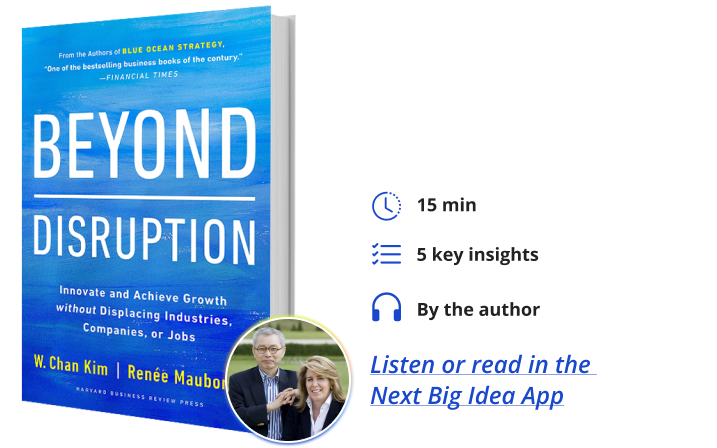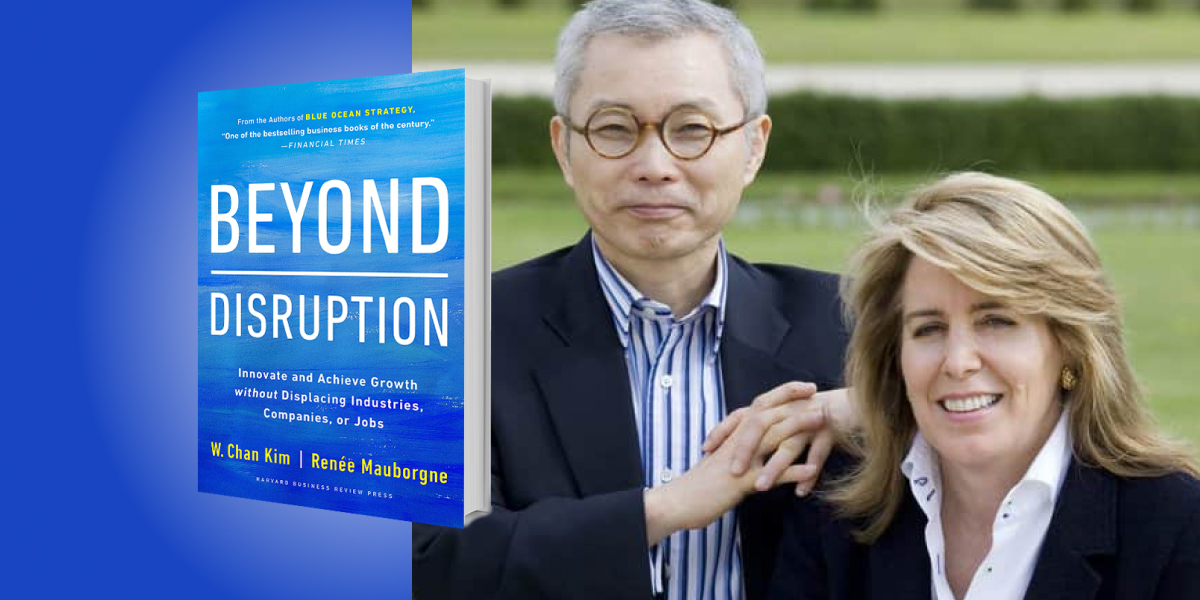W. Chan Kim and Renée Mauborgne are professors of strategy at INSEAD and co-directors of the INSEAD Blue Ocean Strategy Institute in Fontainebleau, France. They are the authors of the over 4 million copy global bestseller Blue Ocean Strategy, which is recognized as one of the most iconic and impactful strategy books ever written, and the New York Times and #1 Wall Street Journal bestseller Blue Ocean Shift.
To date, Blue Ocean Strategy and Blue Ocean Shift teaching materials have been adopted by over 2800 universities across the globe. In 2023 Kim and Mauborgne were honored as two of the four leading thinkers in the 100 years of Harvard Business Review’s publication for the global impact of their body of research and ideas. They have published numerous articles in top academic and managerial journals including Management Science, Administrative Science Quarterly, Academy of Management Journal, and Organization Science, among others. In 2019, Kim and Mauborgne were named the most influential management thinkers in the world by Thinkers50.
Below, Renée shares 5 key insights from her and Chan’s new book, Beyond Disruption: Innovate and Achieve Growth without Displacing Industries, Companies, or Jobs. Listen to the audio version—read by Renée—in the Next Big Idea App.

1. Innovation does not have to be disruptive.
For the past 20 years, disruption has been the battle cry of business, “Disrupt this,” “Disrupt that,” “Disrupt or die.” Calls for disruption have rung out across Silicon Valley, major corporate boardrooms, the media, and business conferences around the globe. Not surprisingly, many have come to see disruption as a near synonym for innovation. But is disruption the only way to innovate and grow? With new research brought to light, we are learning that the answer is no.
It may be what people talk about. It’s certainly important, and it is all around us. But the overriding focus on disruption has led us to largely overlook an alternative path to innovation and growth that requires no displacement. It’s what we call non-disruptive creation or creation without disruption. Non-disruptive creation generates new industries and strong growth, but without leaving failed companies, lost jobs, and destroyed markets in its wake. It offers the immense potential to innovate new markets where none existed before. We reason that if we could better understand this other form of market-creating innovation, we’d be better equipped to achieve it.
Non-disruptive creation can’t be defined as innovative, or new technology, or new-to-the-world innovation, or confined to any specific geographic market or socioeconomic level. It is a distinct new concept.
2. Non-disruptive creation is a positive-sum approach to innovation and growth where business and society can thrive together.
The world is waking up to realize that costly negative externalities have often been imposed on society and our communities in the pursuit of profit. Therefore, there is now a growing call for businesses to consider the impact of an organization’s actions on the broader stakeholders of society.
“What then, is a viable future strategic direction for innovation as a key engine of economic growth, if it must play a positive sum role for society?”
To answer these calls, firms are increasingly urged to pursue their strategies in a win-win manner for themselves and society. Their innovation strategies for growth are no exception. What then, is a viable future strategic direction for innovation as a key engine of economic growth, if it must play a positive sum role for society? Answering this question is neither easy nor intuitive, and there are most likely various ways to achieve this goal. However, when it comes to the innovation of new markets, our research shows that non-disruptive creation presents a viable path toward addressing this challenge.
Here, social good is not a sideshow. Rather, it is locked into economic good by its very nature of creating, and does so without destroying. Thus, it generates non-disruptive growth. In other words, with non-disruptive creation, social good is not achieved in how companies spend money, but begins to be achieved in the very way they make money to thrive and prosper.
3. The relevance and importance of non-disruptive creation will grow in the future as we face the fourth industrial revolution.
The fourth industrial revolution, which we’re now experiencing, encompasses the advent and convergence of exponential technologies from artificial intelligence to smart machines that are already affecting the way we live. All these new technologies are on track to deliver leaps and productivity greater than we have ever seen before, and with these leaps and productivity will come increasingly lower costs and greater efficiencies, which is good, only there is a hitch. To purchase these lower-priced goods and services and enjoy the promised higher standard of living that productivity has historically delivered, it goes without saying that people must have jobs and sound income. Without jobs and income, no matter how efficient, low-cost, and high-quality goods and services become through technological advances, people won’t have the means to purchase them.
“We’ve never had a technological revolution that has been capable of displacing so many human beings and so much human brain power as the one we are transitioning through now.”
Herein lies the double-edged sword of the fourth industrial revolution. Although smart machines and artificial intelligence are predicted to bring unimaginable efficiencies, they will do so by increasingly replacing a wide swath of existing human jobs. While historically jobs have always been around for human beings through technological revolutions, we’ve never had a technological revolution that has been capable of displacing so many human beings and so much human brain power as the one we are transitioning through now. This is why the concept of non-disruptive creation, creating new industries and new jobs without destroying existing ones, is so relevant to meet the challenge of lost human jobs posed by the fourth industrial revolution. With non-disruptive creation, we open a new innovation path to achieve economic growth and create new jobs without incurring the social disruption of lost jobs and hurt communities to help all of us move forward to a productive and beneficial future.
4. Disruption and non-disruptive creation complement one another.
Both disruption and non-disruptive creation have distinctive roles to play and distinctive consequences. Disruption occurs when you create a new market within the bounds of existing industries, like how Amazon disrupted and displaced booksellers and main street retail, or how Uber did the same to the taxi industry. Non-disruptive creation occurs when you create a brand-new market outside the boundaries of existing industries, where there are no established players or markets to displace.
When industries are asleep at the wheel, ineffective, inefficient, or produce pronounced negative side effects on the environment or the well-being of people, those industries become prime targets for disruption. Non-disruptive creation, in contrast, doesn’t take aim at an existing industry. Instead, it directs you to solve brand new problems no industry currently addresses. It can also create brand-new opportunities beyond existing industry boundaries. This allows growth without confrontation.
Take life coaching: it created a brand-new opportunity for people to improve their professional and personal lives that had never existed before, unlocking a new industry. It offered strong, profitable growth, and thousands of new jobs, without needing to confront or displace any existing industry or market players.
“Non-disruptive creation, in contrast, doesn’t take aim at an existing industry.”
In so doing, non-disruptive creation gives advantages that every company will want to understand so it can take advantage of them. One is it allows you to avoid confrontation, or taking on established players, in achieving innovation and growth. Why poke the bear when there is a way to win without sparking retaliation?
Another advantage, counterintuitively, is that it provides a viable response to full-on disruption. If your company faces disruption, you’ll want to understand how you can pivot and counter disruption with a non-disruptive response instead. Through non-disruptive responses, you can broaden your strategic reaction to the changes rising in the world, and understand how best to achieve innovation and growth in your organization.
5. Non-disruptive creation doesn’t have to be the outcome of a random process. It can be generated by a systematic approach.
We studied whether a pattern exists and how companies generate non-disruptive creation. Our aim was to pinpoint the reoccurring actions of non-disruptive creators and codify them. Then other organizations could apply the pattern to pursue non-disruptive opportunities in a more systematic way.
There are three basic steps common to organizations and individuals who have created and captured a non-disruptive new market. In building block one, we outline the paths to identify and spot non-disruptive opportunities that may be on the horizon or right in front of you. Here we address the important questions of how to assess the size of the market potential and how to scope the opportunity so it becomes practically and emotionally feasible to act on.
In building block two, we dive into how to find a way to unlock the opportunity. Here we introduce the assumption implication analysis, which allows you to get clear on all the unspoken assumptions that have blocked the opportunity and how to reframe them to find a way to unlock it.
And lastly, in building block three, we highlight how to secure the needed enablers and realize the opportunity in a high-value, low-cost way. Through these three blocks, organizations can learn to act on and seize non-disruptive opportunities in pursuit of innovation and growth for the future.
To listen to the audio version read by co-author Renée Mauborgne, download the Next Big Idea App today:






























